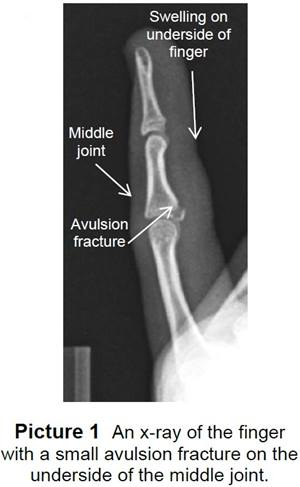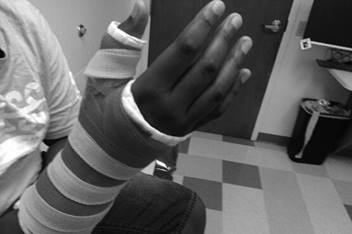Volar Plate Injuries
![]()
A volar plate injury is commonly called a jammed or sprained finger. It happens when the finger is bent back or to the side too far (hyperextended).
The middle joint in a finger has 3 ligaments that wrap around it to move and support it. Ligaments are tissues that connect 2 bones together. They let a finger bend, straighten, and stop from bending too far back or sideways.

- Volar plate – A thick ligament on the underside of the middle finger joint. It keeps the finger from hyperextending back.
- Collateral ligaments – 2 ligaments, 1 on each side of the joint, that control how the finger bends and straightens. They prevent the finger from hyperextending sideways.
- When a finger bends back or sideways too far, the volar plate and one or both of the collateral ligaments can be torn. Sometimes, the injury may break off a small piece of bone. This type of broken bone is called an avulsion fracture (Picture 1).
Signs and Symptoms
With a volar plate injury, the joint will have:
- Pain right away and with slight movement
- Bruising
- Swelling
Diagnosis
To know if your child has a sprain or an avulsion fracture, the doctor or health care provider will order an X-ray of the finger.
Treatment
- For the first few days, the injured joint should rest. Rest and reduced joint movement will help the ligaments heal and the swelling go down.
- To control how much the joint moves, your child may get a splint.
- After a few days to 1 week of splinting, 2 of your child’s fingers will be taped together. This is called buddy taping.
- Buddy taping is the most common treatment for volar plate avulsion fractures.
- The finger that is not hurt acts like a splint for the sprained finger.
- The injured finger can move safely. Buddy taping stops the injured finger from moving hyperextending or side-to-side.
- Being able to move the injured finger early on can help prevent stiffness.
- For pain and swelling:
- Give your child ibuprofen (Motrin® or Advil®) or acetaminophen (Tylenol®). Read the label to know the right dose for your child.
- Do not give your child aspirin.
- The joint pain should go away in a few days. If there is still joint pain and stiffness at 3 to 4 weeks, call your child’s doctor or health care provider.
- Your child may start to exercise the finger a few days to 1 week after the injury. The finger may still be buddy-taped.
- They should begin by gently bending the finger.
- Gradually increase the amount and strength of the exercises until the finger is back to normal.
What to Expect
- The volar plate ligament should heal in a few weeks, but the joint may stay swollen longer. If the collateral ligaments are also stretched or torn, the bulge or swelling at the joint can last a very long time. It may never completely go away. However, this will not keep the finger from bending normally after healing.
- It may take a few weeks for your child to fully bend their finger. It will get better with time.
- Your child may need to limit sports activities for 1 to 2 weeks, or until they get back full motion. This will depend on how bad the injury was.
A child will with a volar plate injury will not usually need any therapy.
HH-I-410 | ©2016, revised 10/2022 | Nationwide Children's Hospital

